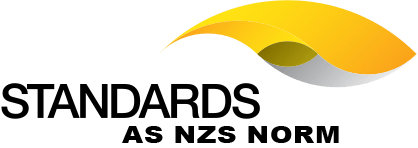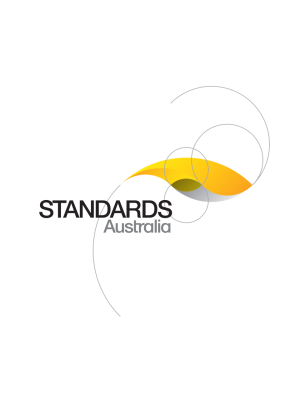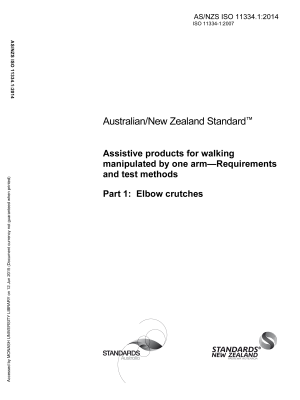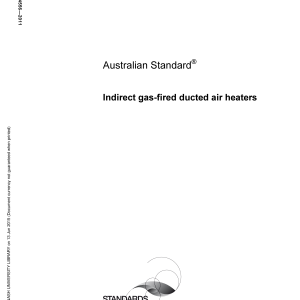- You cannot add another "AS 3570-1998" to your cart. View cart
🔍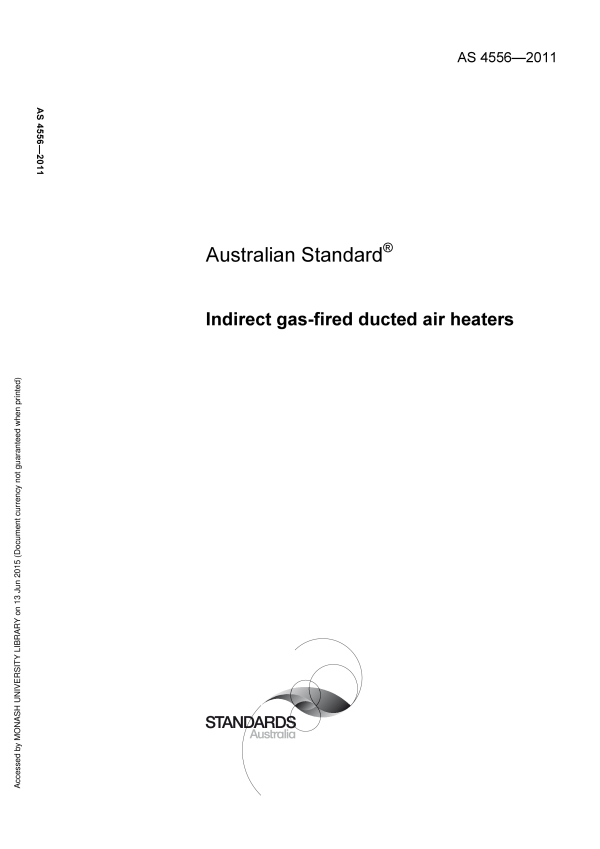

Purchase the full subscription package now and enjoy a 40% discount, along with free updates for future editions.
AS 4556-2011
$321.76
Indirect gas-fired ducted air heaters
Specifies requirements for indirect gas-fired ducted air heaters with natural draught or fan-assisted combustion systems intended for use with NG, town gas, LP Gas and tempered liquefied petroleum gas (TLP) with gas consumptions not exceeding 500 MJ/h.
Table of contents
Header
About this publication
Preface
1 Scope and general
1.1 Scope
1.2 Referenced documents
1.3 Definitions
2 Design and construction
2.1 General
2.1.1 Preliminary specification
2.1.2 Physical inspection
2.1.3 Certification of safety components
2.1.4 Programmable electronic systems
2.1.5 Manual shut-off gas valves
2.1.6 Classification of safety shut-off valves
2.1.7 Power failure
2.1.8 Fluing
2.1.9 Automatic operation
2.1.10 Draught diverter
2.1.11 Thermostat connection
2.1.12 Sharp edges
2.1.13 Handles and knobs
2.1.14 Continuity of satisfactory operation
2.1.15 Insulation
2.1.16 Protection of vitreous enamel
2.1.17 Means of support
2.1.18 Alternative forms
2.1.19 Means of ignition—Room-sealed appliances
2.1.20 Locking of adjusting devices
2.1.21 Sealing of programmed ignition adjustments
2.1.22 Gas pressure measurement
2.2 Materials
2.2.1 General
2.2.2 Materials containing asbestos
2.2.3 Materials in contact with gas
2.2.4 Zinc-based alloys
2.2.5 Components required to be placed in a flame
2.2.6 Spark electrodes
2.2.7 Protection of aluminium tubing
2.2.8 Thermal insulation
2.2.9 Compression fittings
2.2.10 Corrosion resistant base
2.3 Electrical systems
2.3.1 Connection to the mains electrical supply
2.3.2 Motor bearings suitability
2.4 Installation requirements
2.4.1 Fixing of gas inlet connection
2.4.2 Gas inlet connection thread
2.4.3 Access to connections
2.5 Maintenance requirements
2.5.1 Dismantling and replacement by the user
2.5.2 Insertion and removal of gas injectors
2.5.3 Assembly and attachment of handles, dials and pointers
2.5.4 Accessibility for adjustment
2.5.5 Accessibility for replacement
2.5.6 Screwed connections
2.5.7 Inaccessible nuts or bolts
2.6 Pressure regulators
2.6.1 Provision of a pressure regulating device
2.6.2 Positioning of pressure regulators
2.7 Gas controls and safety shut-off systems
2.7.1 General
2.7.2 Accessibility of controls
2.7.3 Accidental change of settings
2.7.4 Provision of flame safeguard
2.7.5 Automatic shut-off valves
2.7.6 Pilot burner failure
2.7.7 Multiple burner units
2.7.8 Independent supervised ignition systems
2.7.9 Thermostatic control
2.8 Combustion air supply and controls
2.8.1 Combustion air supply equipment
2.8.2 Combustion air flow proving interlock
2.8.3 Prevention of combustion air backflow
2.9 Ignition, pilots and main burners
2.9.1 Remote manual ignition
2.9.2 Direct manual ignition
2.9.3 Prevention of injury at ignition
2.9.4 Manually operated burners in an enclosed compartment
2.9.5 Burners interconnected by flues or passages
2.9.6 Means for turning off pilot burner gas supply
2.9.7 Means of ignition
2.9.8 Viewing of flames
2.9.9 Proving that a burner is alight
2.9.10 Location of flash lighting tubes
2.9.11 Cross lighting
2.9.12 Support of pilots, igniters and flame-sensing devices
2.9.13 Location of burner mixing tubes
2.9.14 Burner supports
2.9.15 Fixing of gas manifolds
2.9.16 Protection of ports and injectors
2.9.17 Restriction on gauze over primary air ports
2.9.18 Pilot gas filters
2.9.19 Aeration adjustment for universal LP Gas appliances
2.10 Flueing requirements
2.10.1 Design of air entry and combustion product discharge
2.10.2 Design of flue connection
2.10.3 Design of flue baffles and draught diverters
2.10.4 Flue terminal openings
2.11 Markings and labels
2.11.1 Markings on packaging or appliance
2.11.2 Gas type label
2.11.3 Gas type colour code
2.11.4 Identification of injectors
2.11.5 Marking of fans
2.11.6 Markings on appliances
2.11.7 Marking of doors and covers
2.11.8 Warning label regarding removing of components
2.11.9 Flue terminal marking
2.11.10 Design conditions
2.11.11 Energy label
2.11.12 Gas valve ‘off’ position
2.12 Instructions
2.12.1 Documents remaining with user
2.12.2 Installation
2.12.3 Operating
2.12.3.1 General
2.12.3.2 Service-related information
2.12.3.3 Safety warnings
2.12.3.4 Lighting instructions
2.12.3.5 Servicing instructions
2.12.3.6 Inclusion of warning to prohibit unauthorized servicing
3 Preliminary tests—Line gases
3.1 General requirements
3.1.1 Introduction
3.1.2 Test gases
3.2 Preparation for testing
3.2.1 Electrical safety requirements (earth leakage)
3.2.2 Setting up appliance for testing
3.2.3 Appliance regulators not to be removed during testing
3.2.4 Protection from accidental draughts
3.2.5 Prevention of gas rate variation
3.2.6 Gas pressure and gas volume test equipment
3.3 Gas leakage
3.3.1 Gas circuit soundness
3.3.2 Bleed lines
3.4 Gas consumption
3.4.1 Tolerance on determined gas consumption
3.4.2 Determined gas consumption of permanent pilots
3.5 Gas pressure regulators
3.6 Ignition and safety shut-off systems
3.6.1 Requirements applicable to all ignition and safety shut-off systems
3.6.1.1 Aerated pilots
3.6.1.2 Ignition at reduced pilot rate
3.6.1.3 Means of ignition other than permanent pilot
3.6.1.4 Multi-port pilots
3.6.1.5 Holding time for thermoelectric flame safeguard
3.6.1.6 Flame safeguard required
3.6.1.7 Flame travel at ignition
3.6.1.8 Cessation of ignition spark
3.6.1.9 Commencement of ignition after purge period
3.6.1.10 Proving of start flame
3.6.1.11 Self-check for safety shut-off systems
3.6.1.12 Flame failure
3.6.1.13 Flame establishment period for intermittent pilot
3.6.1.14 Shut-off time for safety shut-off system
3.6.1.15 Interrupted pilot
3.6.2 Automatic burner ignition systems—Additional requirements
3.6.2.1 Atmospheric burners
3.6.2.1.1 Start flame establishment period
3.6.2.1.2 Ignition gas flow rate
3.6.2.1.3 Start flame proving period
3.6.2.1.4 Number of reignition attempts
3.6.2.2 Forced or induced draught burners
3.6.2.2.1 Ignition gas flow rate
3.6.2.2.2 Start flame proving period
3.6.2.2.3 Number of reignition attempts
3.6.2.2.4 Preignition purge period
4 Limit gas tests
4.1 General
4.2 CO/CO2 ratio limits for any independent burner—Overload
4.3 CO/CO2 ratio limits for permanent pilots—Overload
4.4 Flame abnormality
4.5 Burner ignition at maximum and minimum limiting conditions
4.6 Flame stability to draught
4.7 Noise of extinction
4.8 Burner stability when changing setting
4.9 Pilot ignition and stability at maximum and minimum limiting conditions
4.10 Effect of opening and closing doors at turndown condition
4.11 Unburnt gas release from burner system
4.12 Burner interference at ignition or during combustion
4.13 Case pressure
5 Performance tests
5.1 General
5.2 Flue operation
5.2.1 Spillage of combustion products
5.2.2 Circulating air system
5.2.3 Performance with updraught, downdraught and blocked flue
5.2.4 Natural draught, open-flued appliances
5.2.5 Forced or induced draught, open-flued appliances
5.3 Thermal efficiency
5.3.1 General
5.3.2 Reduction in thermal efficiency with maximum flue length
5.3.3 CO2 reduction in wind conditions
5.4 Flue gas temperature
5.5 Condensation
5.5.1 Control of flue gas condensate
5.5.2 Condensate interference with combustion
5.5.3 Blocked condensate drain
5.6 Combustion air supply
5.6.1 Combustion air flow proving
5.6.2 Automatic air control
5.6.3 Power failure
5.6.4 Response to electrical power variation or failure
5.7 Interlock systems
5.7.1 General
5.7.2 Interlocks to ensure safe ignition conditions
5.7.3 Interlocks to ensure safe reignition conditions
5.8 Temperature hazards
5.8.1 Test conditions
5.8.2 Surrounding surfaces—Temperature limits
5.8.3 Personal safety—Temperature limits
5.8.3.1 Surface intended to be handled
5.8.3.2 Surfaces likely to be accidentally touched
5.8.4 Appliance safety—Temperature limits
5.8.4.1 Bodies of gas valves, thermostats, etc
5.8.4.2 Components containing non-metallic diaphragms
5.8.4.3 Body of a clock or timer
5.8.4.4 Main gas and pilot lines susceptible to sulphide attack
5.8.4.5 Flexible hoses
5.8.4.6 Joints sealed with jointing materials
5.8.4.7 Maximum outlet air temperature limiting device
5.8.4.8 Secondary maximum outlet air temperature limiting device
5.9 Heat resistance
5.9.1.1 Heat resistance—Overload conditions
5.9.1.2 Heat resistance—Light back condition
5.10 Durability of heat exchangers
5.10.1 Minimum temperature requirements of heat exchangers during warming-up period
5.10.2 Maximum temperature requirements for heat exchanger materials
5.10.3 Heat exchanger cycling
5.11 Wind test
5.11.1 General
5.11.2 Power-flued appliances
5.11.3 Sealing of room-sealed appliances
5.11.4 Failure of the fan
5.11.5 Pilot burner ignition under wind conditions
5.11.6 Pilot burner stability under wind conditions
5.11.7 Main burner ignition under wind conditions
5.11.8 Flame safeguard operation under wind conditions
5.11.9 Appliance operation under wind conditions
5.11.10 Appliance safety under wind conditions
5.12 Fan performance
5.13 Linting tests
5.13.1 Appliance operation under linting conditions
5.13.2 Protection of fan and motor bearings
5.13.3 Construction of aeration controls
5.14 Rain test
5.14.1 Rain resistance—Appliances for outdoor installation
5.14.2 Rain resistance—Room-sealed appliances
5.15 Strength
5.15.1 Bearing pressure
5.15.2 Strength of flue connection
5.16 Specifications
5.17 Energy labelling
Appendix A
Appendix B
B1 M.O.T. 2.2.4—Zinc alloy test
B1.1 Scope
B1.2 Principle
B1.3 Apparatus
B1.4 Procedure
B1.5 Result
B2 M.O.T. 2.11—Markings and labels
B2.1 Scope
B2.2 Principle
B2.3 Apparatus
B2.4 Materials
B2.5 Procedure
B2.6 Result
B3 M.O.T. 3.3.1—Gas leakage
B3.1 Scope
B3.2 Principle
B3.3 Apparatus
B3.4 Materials
B3.5 Preparation of apparatus
B3.6 Procedure
B3.7 Result
B4 M.O.T. 3.4.1/2—Gas consumption
B4.1 Scope
B4.2 Principle
B4.3 Apparatus
B4.4 Materials
B4.5 Preparation of apparatus
B4.6 Procedure
B4.7 Result
B5 M.O.T. 3.5—Gas pressure regulator performance
B5.1 Scope
B5.2 Principle
B5.3 Apparatus
B5.4 Materials
B5.5 Preparation of apparatus
B5.6 Procedure
B5.7 Result
B6 M.O.T. 3.6.1/4—Ignition—Aerated pilots
B6.1 Scope
B6.2 Principle
B6.3 Apparatus
B6.4 Materials
B6.5 Preparation of apparatus
B6.6 Procedure
B6.7 Results
B7 M.O.T. 3.6.1.2/4—Ignition of a burner protected by a flame safeguard system
B7.1 Scope
B7.2 Principle
B7.3 Apparatus
B7.4 Materials
B7.5 Preparation of apparatus
B7.6 Procedure
B7.7 Result
B8 M.O.T. 3.6.1.5—Ignition—Opening of flame safeguard system
B8.1 Scope
B8.2 Principle
B8.3 Apparatus
B8.4 Materials
B8.5 Preparation of apparatus
B8.6 Procedure
B8.7 Result
B9 M.O.T. 3.6.1.14—Operation of safety shut-off system
B9.1 Scope
B9.2 Principle
B9.3 Materials
B9.4 Apparatus
B9.5 Preparation of apparatus
B9.6 Procedure
B9.7 Result
B10 M.O.T. 3.6.2.1.2(c)/3.6.2.2.1(c)—Start flame establishment period—Delayed ignition tests
B10.1 Scope
B10.2 Principle
B10.3 Apparatus
B10.4 Materials
B10.5 Preparation of apparatus
B10.6 Procedure
B10.7 Result
B11 M.O.T. 3.6.2.1.4—Automatic burner ignition systems for atmospheric burners
B11.1 Scope
B11.2 Principle
B11.3 Apparatus
B11.4 Materials
B11.5 Preparation of apparatus
B11.6 Procedure
B11.7 Result
B12 M.O.T. 4.2—Determination of CO/CO2 ratio of combustion products—Overload
B12.1 Scope
B12.2 Principle
B12.3 Apparatus
B12.4 Materials
B12.5 Preparation of apparatus
B12.6 Procedure
B12.7 Result
B13 M.O.T. 4.3—Determination of CO/CO2 ratio of combustion products—Permanent pilots
B13.1 Scope
B13.2 Principle
B13.3 Apparatus
B13.4 Materials
B13.5 Preparation of apparatus
B13.6 Procedure
B13.7 Result
B14 M.O.T. 4.4—Flame abnormality
B14.1 Scope
B14.2 Principle
B14.3 Apparatus
B14.4 Materials
B14.5 Preparation of apparatus
B14.6 Procedure
B14.7 Result
B15 M.O.T. 4.5—Ignition tests
B15.1 Scope
B15.2 Principle
B15.3 Apparatus
B15.4 Materials
B15.5 Preparation of apparatus
B15.6 Procedure
B15.7 Result
B16 M.O.T. 4.6—Flame stability to draught
B16.1 Scope
B16.2 Principle
B16.3 Apparatus
B16.4 Materials
B16.5 Preparation of apparatus
B16.6 Procedure
B16.7 Result
B17 M.O.T. 4.9—Pilot flames—Ignition and stability
B17.1 Scope
B17.2 Principle
B17.3 Apparatus
B17.4 Materials
B17.5 Preparation of apparatus
B17.6 Procedure
B17.7 Result
B18 M.O.T. 4.10—Effect of appliance door operation on burner stability
B18.1 Scope
B18.2 Principle
B18.3 Apparatus
B18.4 Materials
B18.5 Preparation of apparatus
B18.6 Procedure
B18.7 Result
B19 M.O.T. 4.11—Burner operation—Unburnt gas spillage from burner system
B19.1 Scope
B19.2 Principle
B19.3 Apparatus
B19.4 Materials
B19.5 Preparation of apparatus
B19.6 Procedure
B19.7 Result
B20 M.O.T. 4.13—Case pressure test
B20.1 Scope
B20.2 Principle
B20.3 Apparatus
B20.4 Materials
B20.5 Preparation of apparatus
B20.6 Procedure
B20.7 Result
B21 M.O.T. 5.2.1—Flue operation—Spillage test
B21.1 Scope
B21.2 Principle
B21.3 Apparatus
B21.4 Materials
B21.5 Preparation of apparatus
B21.6 Procedure
B21.7 Result
B22 M.O.T. 5.2.3.1—Combustion with flue blockage, downdraught or updraught—Natural draught appliances
B22.1 Scope
B22.2 Principle
B22.3 Apparatus
B22.4 Materials
B22.5 Preparation of apparatus
B22.6 Procedure
B22.7 Result
B23 M.O.T. 5.2.3.2—Combustion with flue blockage, downdraught or updraught—Forced or induced draught appliances
B23.1 Scope
B23.2 Principle
B23.3 Apparatus
B23.4 Materials
B23.5 Preparation of apparatus
B23.6 Procedure
B23.7 Result
B24 M.O.T. 5.3.1/2—Thermal efficiency—Heat content of flue gases
B24.1 Scope
B24.2 Principle
B24.3 Apparatus
B24.4 Materials
B24.5 Preparation of apparatus
B24.6 Procedure 1: Open-flued appliances
B24.7 Procedure 2: Room-sealed or power-flued appliances
B24.8 Calculation
B24.9 Result
B25 M.O.T. 5.3.3—Flue terminal wind test
B25.1 Scope
B25.2 Principle
B25.3 Apparatus
B25.4 Materials
B25.5 Preparation of apparatus
B25.6 Procedure
B25.7 Result
B26 M.O.T. 5.4—Flue gas temperature test
B26.1 Scope
B26.2 Principle
B26.3 Apparatus
B26.4 Materials
B26.5 Preparation of apparatus
B26.6 Procedure
B26.7 Result
B27 M.O.T. 5.5.3—Blocked condensate drain
B27.1 Scope
B27.2 Principle
B27.3 Apparatus
B27.4 Materials
B27.5 Preparation of apparatus
B27.6 Procedure
B27.7 Result
B28 M.O.T. 5.6.1/2—Flame abnormality on progressive air supply restriction
B28.1 Scope
B28.2 Principle
B28.3 Apparatus
B28.4 Materials
B28.5 Preparation of apparatus
B28.6 Procedure
B28.7 Result
B29 M.O.T. 5.6.3/4—Safe performance with electricity supply variation
B29.1 Scope
B29.2 Principle
B29.3 Apparatus
B29.4 Materials
B29.5 Preparation of apparatus
B29.6 Procedure
B29.7 Result
B30 M.O.T. 5.8—Temperature hazards
B30.1 Scope
B30.2 Principle
B30.3 Apparatus
B30.4 Materials
B30.5 Preparation of apparatus
B30.6 Procedure
B30.7 Result
B31 M.O.T. 5.9.1—Heat resistance—Overload condition
B31.1 Scope
B31.2 Principle
B31.3 Apparatus
B31.4 Materials
B31.5 Preparation of apparatus
B31.6 Procedure
B31.7 Result
B32 M.O.T. 5.9.2—Heat resistance—Light back condition
B32.1 Scope
B32.2 Principle
B32.3 Apparatus
B32.4 Materials
B32.5 Preparation of apparatus
B32.6 Procedure
B32.7 Result
B33 M.O.T. 5.10.1/2—Heat exchangers, maximum/minimum temperature test
B33.1 Scope
B33.2 Principle
B33.3 Apparatus
B33.4 Materials
B33.5 Preparation of apparatus
B33.6 Procedure
B33.7 Result
B34 M.O.T. 5.10.3—Durability of heat exchangers
B34.1 Scope
B34.2 Principle (A)
B34.3 Principle (B)
B34.4 Apparatus
B34.5 Materials
B34.6 Preparation of apparatus (A)
B34.7 Procedure (A)
B34.8 Preparation of apparatus (B)
B34.9 Procedure (B)
B34.10 Result
B35 M.O.T. 5.11—Wind test
B35.1 Scope
B35.2 Principle
B35.3 Apparatus
B35.4 Materials
B35.5 Preparation of apparatus
B35.6 Procedure
B35.7 Result
B36 M.O.T. 5.12—Pressure/delivery characteristics
B36.1 Scope
B36.2 Principle
B36.3 Apparatus
B36.4 Preparation of apparatus
B36.5 Procedure
B36.6 Result
B37 M.O.T. 5.13.1/2/3—Linting test
B37.1 Scope
B37.2 Principle
B37.3 Apparatus
B37.4 Materials
B37.5 Preparation of apparatus
B37.6 Procedure
B37.7 Result
B38 M.O.T. 5.14.1/2—Rain resistance of outdoor appliances and flue terminals of room-sealed appliances
B38.1 Scope
B38.2 Principle
B38.3 Apparatus
B38.4 Materials
B38.5 Preparation of apparatus
B38.6 Procedure
B38.7 Result
B39 M.O.T. 5.15.1—Floor loading test
B39.1 Scope
B39.2 Principle
B39.3 Apparatus
B39.4 Procedure
B39.5 Result
B40 M.O.T. 5.15.2—Strength—Loading test
B40.1 Scope
B40.2 Principle
B40.3 Apparatus
B40.4 Preparation of apparatus
B40.5 Procedure
B40.5.1 For torsional load test on appliance with vertical and horizontal flue spigots
B40.5.2 For vertical load on a appliance with vertical flue
B40.5.3 For vertical load on a appliance with horizontal flue
B40.6 Result
B41 M.O.T. 5.17—Energy labelling test
B41.1 Scope
B41.2 Principle
B41.3 Apparatus
B41.4 Materials
B41.5 Preparation of apparatus
B41.6 Procedure
B41.6.1 General
B41.6.2 Pre-conditioning stage
B41.6.3 Heavy load (75% duty) test
B41.6.4 Light load (25% duty) test
B41.6.5 Standby energy consumption
B41.7 Calculations
B41.7.1 Preliminary
B41.7.2 Appliance efficiency
B41.7.3 System factor calculation
B41.8 Result
B41.8.1 Energy star rating
B41.8.2 Annual energy consumption (AEC)
B41.8.3 ‘Red band’ shading
Appendix C
Appendix D
Appendix E
Appendix F
Appendix G
Appendix H
Appendix I
I1 General
I2 Information to be provided by the appliance manufacturer
I3 Figures
Cited references in this standard
Content history
[Available Superseded]
[Superseded]
[Superseded]
[Superseded]
DR AS 4556
Please select a variation to view its description.
| Published | 03/06/2011 |
|---|---|
| Pages | 141 |
Please select a variation to view its pdf.
